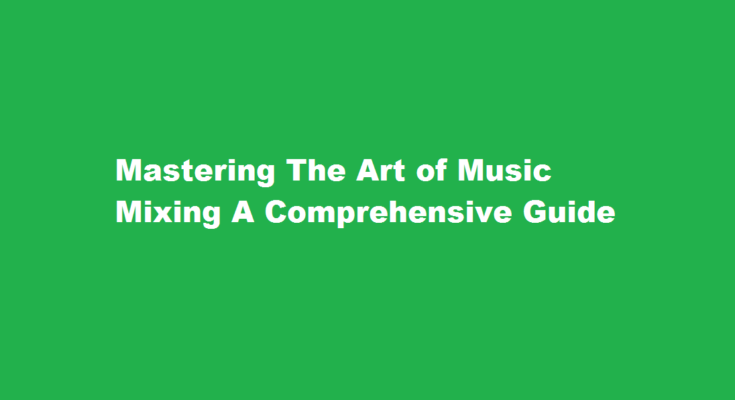Introduction
Music mixing is an essential process that brings various elements of a song together to create a cohesive and balanced final product. Whether you’re an aspiring musician, producer, or DJ, understanding the fundamentals of music mixing is crucial for creating professional-sounding tracks. In this article, we will explore step-by-step techniques and practical tips to help you navigate the world of music mixing and enhance your ability to craft engaging and dynamic audio experiences.
Preparing for Mixing
Before diving into the mixing process, it’s important to ensure that your tracks are well-prepared. Start by organizing your project files, labeling each track appropriately, and eliminating any unnecessary elements. Take time to clean up audio files by removing background noise, pops, or clicks. Additionally, ensure that all tracks are properly recorded and edited to avoid any technical issues during mixing.
Setting Up Your Mix Environment
Create an optimal listening environment for your mixing process. Invest in a pair of high-quality studio monitors or headphones that provide accurate frequency representation. Arrange your workspace in a way that minimizes reflections and unwanted acoustic interference. Consider acoustically treating your room with bass traps, diffusers, and absorbers to achieve a more accurate listening environment.
Balancing Levels and Panning
Achieving a balanced mix begins with setting appropriate levels for each track. Start by adjusting the volume of individual elements, ensuring that they complement each other without overpowering or getting lost in the mix. Utilize panning to position sounds within the stereo field, creating a sense of depth and space. Experiment with different panning positions to enhance the overall width and separation of your mix.
Equalization
Equalization, or EQ, is a fundamental tool used in music mixing to shape the frequency content of individual tracks. Use EQ to carve out space for each element in the mix by boosting or cutting specific frequencies. Pay attention to the low end to avoid muddiness, and address any harsh or shrill frequencies in the high end. Aim for a balanced frequency spectrum that allows every instrument or vocal to shine without clashing with others.
Dynamic Processing
Dynamic processing involves controlling the volume and dynamics of individual tracks or the entire mix. Utilise techniques such as compression, limiting, and gating to even out volume levels, add sustain, or eliminate unwanted noise. Use compression to control the dynamic range of a track, ensuring it sits well within the mix. However, be cautious not to over-compress, as it can result in an unnatural sound. Experiment with different settings to find the right balance between control and transparency.
Time-Based Effects
Reverbs, delays, and other time-based effects add depth and ambience to your mix. Experiment with different types of reverbs and delays to create a sense of space and to enhance the perceived distance between elements. Adjust the parameters, such as decay time and pre-delay, to achieve the desired effect. Be mindful of not overwhelming the mix with excessive reverb or delay, as it can make the overall sound muddy or cluttered.
FREQUENTLY ASKED QUESTIONS
How do you easily mix songs together?
Make a note of any specific parts of the song that you want to stand out when you mix the songs. Play both songs at the same time. Listen to the sound of the songs together to make sure the songs mash well together. Make a note of the tempo of each song to determine if one should be sped up or slowed down.
What makes a good mix?
A good mix is one where all the instruments can be heard clearly, without any one part overpowering the song. The full frequency spectrum should be present, and it should sound good on multiple different playback systems. Above all, a good mix should sound like a coherent musical performance.
Is it hard to mix music?
Mixing is one of the most difficult skills to master in music. A lucky few have natural abilities, but for most musicians mixing is complicated and frustrating with a steep learning curve. What makes it worse is that a great mix has a huge impact on your listeners.
Conclusion
Music mixing is an art form that requires practice, experimentation, and an attentive ear. By following the steps outlined in this article, you’ll be equipped with the foundational knowledge needed to create professional-sounding mixes. Remember to trust your ears and let your creativity guide you throughout the process. As you gain experience, continue to refine your techniques and explore advanced concepts to further enhance your mixing skills. With dedication and persistence, you’ll be well on your way to producing polished and captivating musical arrangements.
Read Also : The Art of Middle-Term Splitting A Balanced Approach to Achieving Long-Term Goals



